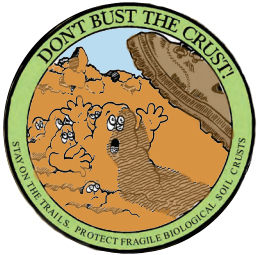Biological Soil Crust
Canyon Country Nature GuideDid you know that the soil here is alive?
When you have been out enjoying the parks and public lands of southeastern Utah, you’ve probably noticed patches of bumpy, clumpy, darkened soil. Although the soil surface may look like just dirt, it is full of living organisms that are a vital part of the desert ecosystem. This veneer of life is called a biological soil crust. Communities that make up soil crust include lichen, mosses, green algae, microfungi, and bacteria, dominated by cyanobacteria.
Protector of the desert
Soil crust helps control erosion by keeping soil stuck together in one continuous crust. This helps keep the sandy soil from washing away in the rain or blowing away in the wind. It also helps plants grow by increasing water retention, and improving soil fertility. Without these effects, animals, and even humans, would not be able to survive well in the desert.
Watch where you step
Unfortunately, humans can destroy soil crust and often do so without meaning to. Vehicle tracks, bicycles, and footprints are extremely damaging to biological soil crust. Impacted areas may never fully recover, and if they do, it may take decades.
Help protect this fragile, but crucial life

Biking and driving:
Stay on established roads and trails.
Camping:
Use designated sites whenever possible. Otherwise set up camp in areas where living crusts don’t form, such as on slickrock, sandy beaches, or under groves of trees.
Hiking:
Stay on established trails. If there is no trail, hike in washes or on rocks.
Make your motto: Don’t Bust The Crust!
To learn more about biological soil crusts, see this fact sheet from the USGS.
